Don't wanna be here? Send us removal request.
Text
Pluralism & Technology
Technological photography can be seen as equipments, techniques, and processes used in the production of photographs.
With technology taking over the world there load of different equpimmets and technically ways one could produce a photograph. In fact the argument in todays society is who is a photographer, because many feel they are one withe easy ascces to the photography world.
Technological photography :
The Digital Imaging Department at the Center for Creative Photography utilizes a host of different types of technology and equipment in its digitization efforts: everything from scanners and scanning technology to digital SLR cameras and digital reprographic systems. The Department also utilizes a variety of software solutions to not only drive the individual imaging systems and provide for post capture image editing.


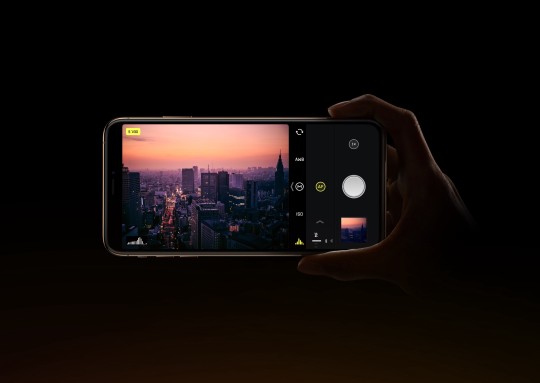

Our live is now dependent on technology like we can’t function without it. The most used and influential technology product is the mobile phone. even to profersional photographers, iphone has become a gadget one can’t do with out and it has been produced in a way that we need it. it’s small, portable, camera quality almost as good a digital camera. It’s a full package, with asccess to ones favorite social apps. Technical photography is beneficial to humans in so many ways. Although having its downsides, it still brings alot tot he table. there are so many things such as, drone shoots, taking picture on a wrist watch that can now be archived in photography with the help of new developed products. There are also young kids who broden their knowledge and ahve easy ascces to these equpimnets that can help them. However having load of information and access could lead to distructions.
https://www.pexels.com/search/technology/
https://unsplash.com/search/photos/technology
https://techcrunch.com/gadgets/
0 notes
Text
Postmodernism & Modernism and Photography
What exactly is modern art?
A style or movement in the arts that aims to break with classical and traditional forms.
Modern art includes artistic work produced during the period extending roughly from the 1860s to the 1970s, and denotes the styles and philosophy of the art produced during that era. The term is usually associated with art in which the traditions of the past have been thrown aside in a spirit of experimentation.
Modernism emerged around the time of the second industrial revolution (1870-1920), which was marked by the decline of stable social classes, the beginning of professionalism, and a sense of urban alienation.
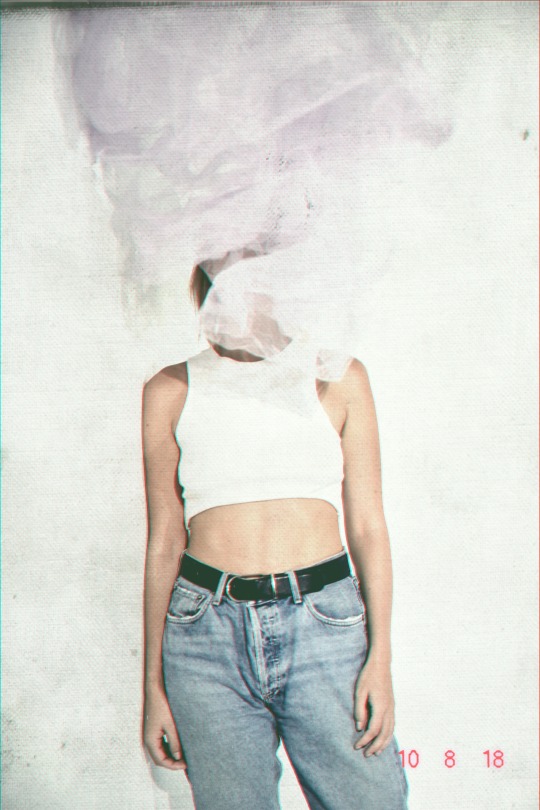
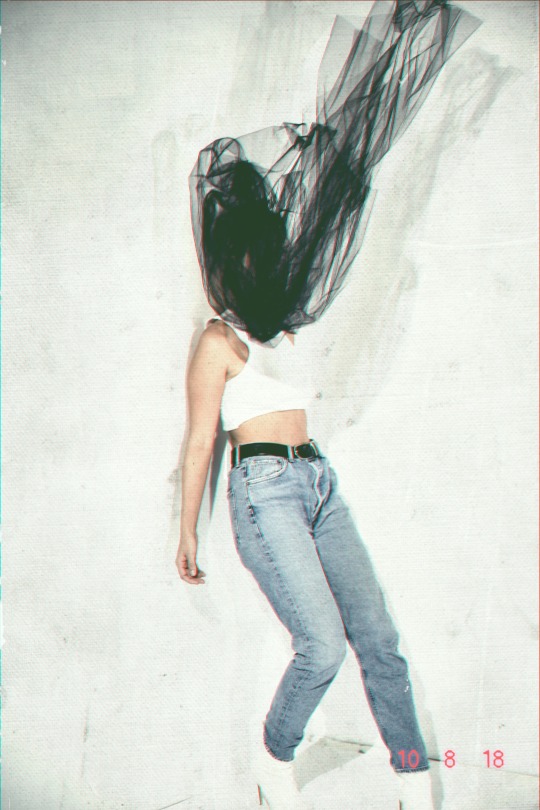
POSTMODERNISM
It’s a movement breaking out of modern art. Postmodernism is an art, social, cultural and philosophical trend that took place in the 1960s in in Europe and the United States and was prominent in the West during the 1980s. It plans to forsake the fundamental reason of innovation and its regulating content. In postmodern workmanship, this relinquishment is showed in the dismissal of pioneer craftsmanship as a free esteem that separates the field of culture and rejects the formal constraint standard and the factional rule of innovation. It's pith is a scholarly enemy of realism, moral pessimism, and passionate joy.
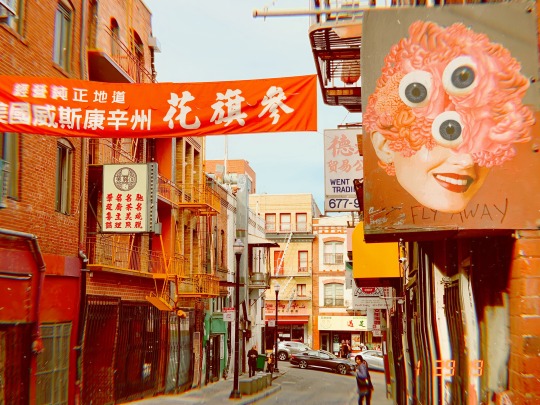

0 notes
Text
Deconstruction
Deconstruction, form of philosophical and literary analysis, derived mainly from work begun in the 1960s by the French philosopher Jacques Derrida, that addresses the key applied qualifications, or "restrictions," in Western theory through a nearby examination of the language and rationale of philosophical and scholarly messages. During the 1970s the term was connected to work by Derrida, Paul de Man, J. Hillis Miller, and Barbara Johnson, among different researchers. During the 1980s it assigned all the more freely a scope of radical hypothetical ventures in assorted zones of the humanities and sociologies, including—notwithstanding reasoning and writing—law, therapy, engineering, human studies, philosophy, woman's rights, gay and lesbian examinations, political hypothesis, historiography, and film hypothesis. In polemical dialogs about scholarly patterns of the late twentieth century, deconstruction was here and there utilized derogatorily to propose agnosticism and trivial distrust. In well known use the term has come to mean a basic disassembling of custom and customary methods of thought.
Death of the Author
Roland Barthes's famous essay "The Death of the Author" (1967) is a meditation on the rules of author and reader as mediated by the text. Barthes's essential argument is that the author has no sovereignty over his own words (or images, sounds, etc.) that belong to the reader who interprets them. When we encounter a literary text, says Barthes, we need not ask ourselves what the author intended in his words but what the words themselves actually say. Text employ symbols which are deciphered by readers, and since function of the text is to be read, the author and process of writing is irrelevant. "The death of the author" notion means that meaning is not something retrieved or discovered, having been there all the while, but rather something spontaneously generated in the process of reading a text, which is an active rather than passive action. Barthes does not intend to suggest that the death of the author lets any reader read any text any way he or she like (though others aside from Barthes perused this line of thought). What Barthes is suggesting is that reading always involves at least a little bit of writing or rewriting of the text's meaning. Barthes's "The Death of the Author" is an attack on traditional literary criticism that focused too much on trying to retrace the author's intentions and original meaning in mind. Instead Barthes asks us to adopt a more text oriented approach that focuses on the interaction of the reader, not the writer, with it. This means that the text is much more open to interpretation, much more fluid in its meaning than previously thought.
Encore: Renactment in Contemporary Photography

“The re-staging of past events presents an opportunity for contemporary photographers to highlight underrepresented stories and to critique established narratives”.

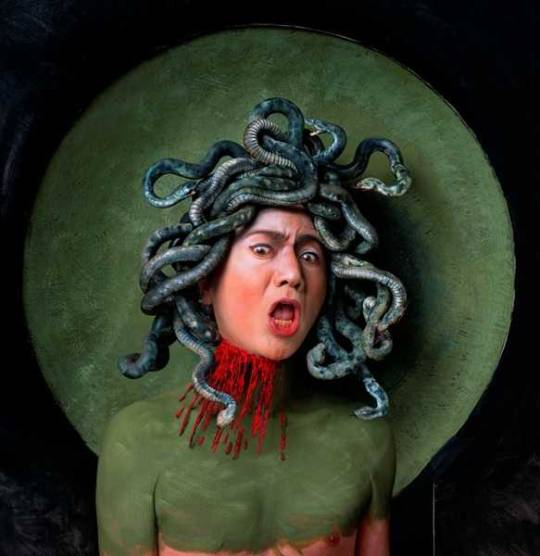
This guy Yasumasa Morimura has been embedding himself into iconic images appropriated from art history, mass media, and popular culture, producing photographs that simultaneously celebrate, satirize, and explore their enduring influence and the stories they convey. This was the one piece of art that i still dont know how it makes me feel. When i first i was very sure i had seen this peice before hand but belonging to a different artist. Having to see the smae art peice with a different artist embeding himself in it.

He even disguises himself as the principal subjects that appear in the artworks he appropriated, many of which goes against his racial, ethnic, and gender boundaries as an Asian male because most of the artworks he appropriates have Western subjects, particularly female subjects.


British-Nigerian photographer Yinka Shonibare explores contemporary cultural identities through the reworking of the 1799 etching The Sleep of Reason Produces Monsters by Spanish artist Francisco de Goya. The series is made of five reimaginings representing each continent Including America (above right) and Asia (above left) in which the sleeping figure juxtapose the continent they represent. His work explores cultural identity, colonialism and post-colonialism within the contemporary context of globalisation. A hallmark of his art is the brightly coloured Dutch wax fabric he uses.
For some of the works I saw, I did not really know how to feel, if I liked them or not. Reason being that some works all in the name of renactment, copy and paste other artist work with just a littel twist to it and it’s their work. That does not really make sense to me when i think of it that way. There is a difference when an original work which is taken and reconstructed in a new different way.
1 note
·
View note
Text
STRUCTURALISM
Susan Meiselas
Susan Meiselas, born in Baltimore, Maryland in 1948, received her BA from Sarah Lawrence College and her MA in visual education from Harvard University. Her first major photographic essay focused on the lives of women doing striptease at New England country fairs, who she photographed during three consecutive summers while teaching photography in New York public schools. Carnival Strippers was originally published in 1976 and a selection was installed at the Whitney Museum of Art in June 2000.

From war and human rights to cultural identity and domestic violence, Susan Meiselas’s work covers a wide range of subjects and countries. This retrospective brings together projects from the beginning of her career in the 1970s to the present day, including her iconic portraits of carnival strippers, vivid color images of the conflicts in Central America in the 1980s, and an ongoing investigation into the history and aftermath of the Kurdish genocide. A member of Magnum Photos since 1976, Meiselas creates work that raises provocative questions about documentary practice, and the relationship between photographer and subject. The exhibition highlights her unique working method, combining photography, video, sound, and installation to explore different scales of time and conflict, ranging from the personal to the geopolitical.
STRUCTURALISM
Structuralism is a method of interpreting and analyzing such things as language, literature, and society, which focuses on contrasting ideas or elements of structure and attempts to show how they relate to the whole structure.
Susan Meiselas and Structuralism


Susan Meiselas traveled to Nicaragua in the late 1970s as a young photographer with an anthropologist’s eye, keen to make sense of the struggle between the long-standing Somoza dictatorship and the socialist Sandinistas fighting to overthrow it. For six weeks she roamed the country, documenting a nation of grinding poverty, stunning natural beauty and wrenching inequality. Meiselas’ work was sympathetic to the Sandinista cause, and she gained the trust of the revolutionaries as they slowly prevailed in the fight. On the day before President Anastasio Somoza Debayle fled, Meiselas photographed Pablo de Jesus “Bareta” Araúz lobbing a Molotov cocktail at one of the last national guard fortresses. After the Sandinistas took power, the image became the defining symbol of the revolution—a reviled dictator toppled by a ragtag army of denim-clad fighters wielding makeshift weapons. Eagerly disseminated by the Sandinistas, Molotov Man soon became ubiquitous throughout Nicaragua, appearing on matchbooks, T-shirts, billboards and brochures. It later became a flash point in the debate over artistic appropriation when the painter Joy Garnett used it as the basis of her 2003 painting Molotov.


According to Susan Meiselas whether or not you can touch the subject sufficiently, the conditions are such that you’re welcome and that you feel there’s value to the work you might produce.”
From the above images we can see different version of the original photograph. different artist have interpreted the image to fit in their concept. some might feel its right others nit really. However, is it right when ideal image with a stroy is manipulated into something it’s not. Some agrue that Susan Meiselas her is already explorting the subject in the photograph by photographing him.
I think it’s difficult for most an artist to see their work being interepreted the wrong way. Or used for something totally different from the original idea. As a a photographer Susan wanted the subjects in her pnhotgraphes to be able to have a voice of their own.

0 notes
Text
Constructivism
Humans are perceivers and interpreters who construct their own reality through engaging in those mental activities. Thinking is grounded in perception of physical and social experiences, which can only be comprehended by the mind. What the mind produces are mental models that explain to the knower what he or she has perceived We all conceive of the external reality somewhat differently, based on our unique set of experiences with the world and our beliefs about them.
History Of Constructivism
The term Constructivism was first used by Kazimir Malevich to portray the works of Alexander Rodchenko in 1917. Constructivism initially shows up as a positive term in Naum Gabo's Realistic Manifesto of 1920. Aleksei Gan utilized the word as the title of his book Constructivism, imprinted in 1922. Constructivism was a post-World War I advancement of Russian Futurism, and especially of the 'counter reliefs' of Vladimir Tatlin, which had been shown in 1915. The term itself would be imagined by the stone workers Antoine Pevsner and Naum Gabo, who built up a modern, precise style of work, while its geometric deliberation owed something to the Suprematism of Kazimir Malevich.
Constructivism as hypothesis and practice was gotten to a great extent from a progression of discussions at the Institute of Artistic Culture in Moscow, from 1920 to 1922. Subsequent to ousting its first executive, Wassily Kandinsky, for his 'mystery', The First Working Group of Constructivists (counting Liubov Popova, Alexander Vesnin, Rodchenko, Varvara Stepanova, and the scholars Aleksei Gan, Boris Arvatov and Osip Brik) would build up a meaning of Constructivism as the blend of faktura: the specific material properties of an item, and tektonika, its spatial nearness. At first the Constructivists dealt with three-dimensional developments as a methods for taking an interest in industry: the Society of Young Artists display demonstrated these three dimensional structures, by Rodchenko, Stepanova, Karl Ioganson and the Stenberg siblings. Later the definition would be stretched out to structures for two-dimensional works, for example, books or notices, with montage and factography getting to be vital ideas.
Alexander Rodchenko
Looking at Liubov popova work reminds me of Alexander Rodchenko’s work whose work is constructivism and his encounters with Russian Futurists propelled him to become an influential founder of the Constructivist movement.
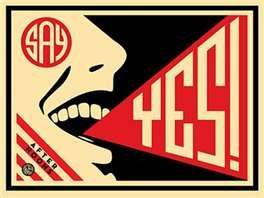
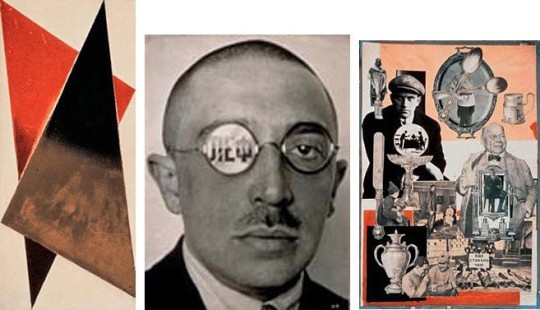
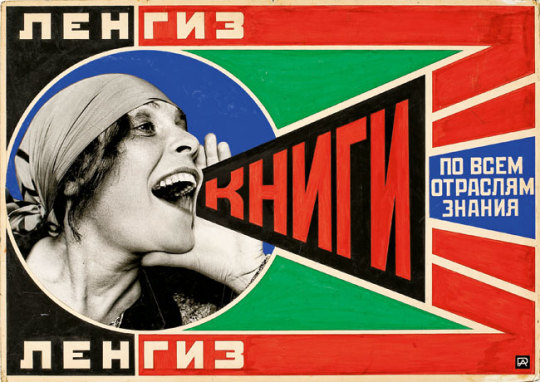
Alexander Rodchenko
Alexander Rodchenko is a Russian painter, photographer and also a graphic designer. HImself and Popova shaped Constructivism, which questioned the fundamental properties of art and asked what its place should be in a new society. The Constructivists challenged the idea of the work of art as a unique commodity, explored more collective ways of working, and looked at how they could contribute to everyday life through design, architecture, industrial production, theatre and film.
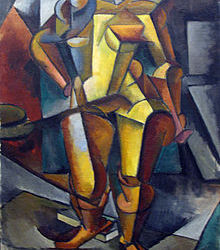
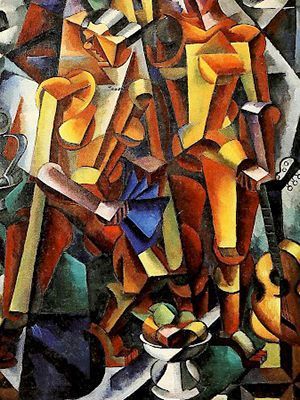
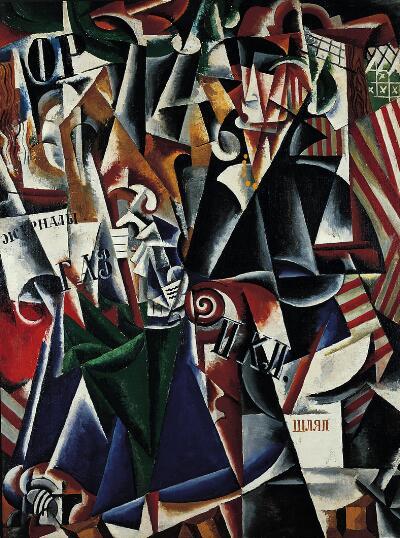
Lyubov popova (Russian , 1889-1924)
The traveler, 1915
Like many young women from prosperous Russian families at the turn of the twentieth century, Popova traveled widely in Europe; unlike her contemporaries, however, she used her travels to develop her talents as a painter, working constantly, studying the Old Masters, and enrolling in the Parisian Académie de la Palette, where her teachers included Jean Metzinger, an early practitioner of Cubism. This abstracted composition suggests the speed and sense of dislocation associated with modern travel and seems to include an oblique self-portrait in the central figure: a woman wearing a yellow necklace and high-collared cape, who reads a magazine or newspaper in her seat on a train, grasping a green umbrella in one gloved hand. Snatches of text (including the Russian words “magazines,” “danger zone,” and “natural gas”) suggest advertisements within the compartment and signposts outside its windows. With her use of found text, fragmented forms, and shapes rhythmically repeated to create a sense of acceleration, Popova here assimilated both French Cubism and Italian Futurism in a uniquely Russian hybrid known as Cubo-Futurism.
looking at the peice of Popova what came to mind was photomontage and Just looking at it i saw different pictures placed in this painting. She was a constructivist, Popova and her four fellow Constructivists declared that easel painting was to be abandoned and all creative work was to be for the people and the making of the new society. Although she was a painter she used her art as a movement for the people in class i was taught that constructivism was a movement for art. It was simply the russian version of modernism. Constructivism was formed in 1914, before the October Revolution in 1917 and the most important figure, which most associate to stand as its founder, was Vladimir Tatlin. Focused on the careful technical analysis of modern materials, and the refusal of the idea that art should be produced for the art’s sake but as a practice for social purposes, Constructivism borrowed the ideas of the above-mentioned Cubism, but also Futurism and its ideas rooted in the celebration of the modern man and the fast and furious machines. It also relied heavily on the criticism and the denial of the spirituality that Suprematism and its leading figure Malevich promoted.
7 notes
·
View notes
Text
PHOTOGRAPHY CRITICISM
Qualities of a photograph that are the most important or useful for making an insightful critique of the image.
Framing
Lighting
Composition
Narrative
Color - black and white or color
Focus - details included and not
perspective/angel
Unique moments
What is in the frame
Creativity
Which genres of photography emphasize certain qualities over others.
Photojournalism: is one of the genres of photography that comes to mind because their are so many rules that goes with gener. I believe since photojournalism is close to documentary photography it has to also have similar rules. “Photojournalism is not about shooting unexpected events, but about capturing unexpected moments at events that are planned. It is serious journalism and a person needs to plan it right to be at the right place and at the right time.” With this said, one is not allowed to manipulate an image shot for their benefit or in a way of trying to make the public see.
Analyze two photographs according to your own criteria: one of yours, one of a classmate’s. “Maddie Smith”
Caricature is what comes to mind when i first saw this project. It was focused on enlarging different parts of the face through using cutouts from another set of face and also with a magnifier. I like the concept of the magnifying glass to enlarge the lips. however, the strong grip of the hand that is holding the magnifying glass which is held onto the lips draws my attention it's not the hand but what the hand is doing. I feel a lot of tension and almost as if their had been an argument before that hand held the magnifier. I find the eyes to be rather piercing, a littel bit scary. They're two different sizes and colors and for some reasons i feel they are both pleading but in different ways. With the way the various parts has been cut out and placed I feel the was making an even obvious emphasis on these parts. The wig is also an interesting i almost overlooked but the wig is like a form of disguise of not wanting to be seen as their true self.
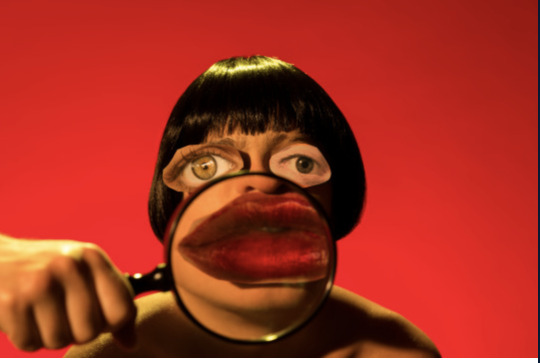
Ansel Adams
He is known to be among the best photographers in the world. He was among a group called the f/64 the aperture which all the members shot at. He was a purist, In references to Ansel Adams works, He was a photographer who paid so much attention to light, tone, details and technical aspect of his work. He worked and experimented in order for his prints to be what he exactly wants them.
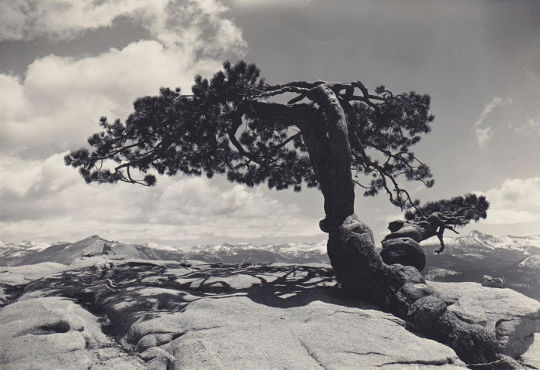
Ansel Adams (1902-1984) - 'Jeffrey Pine Sentinel Dome', Yosemite National Park, California, 1930's
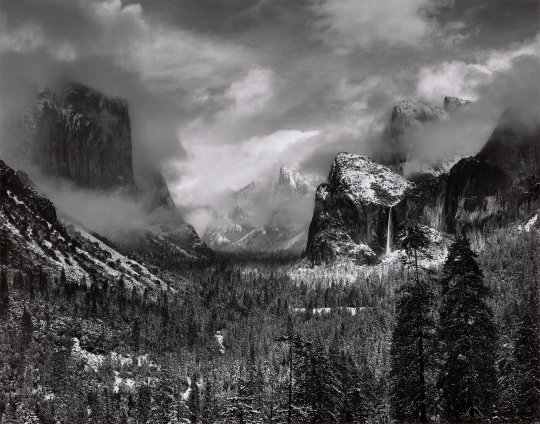
“Clearing Winter Storm, Yosemite National Park,” by Ansel Adams, about 1937.
Purism:
Purism in it's 'rawest form' is about using a manual camera with an optical viewfinder, a manual focus lens, a lens filter, a roll off film and a brain that can determine the exposure in relation to the light and the pressing of the shutter button to fire the shutter and capture the image.
Isuues raised concerning purism

Pictorialism:
Pictorialism was closely linked to prevailing artistic movements, as the photographers took inspiration from popular art, adopting its styles and ideas to demonstrate parity between it and photography. Pictorialist where the ones to start up the conversation a photography being art and doing so discussions such as photographic manipulation was brought up.
William Mortensen
Willianm Mortensen is a successful Hollywood portrait photographer and also a pictorialist. His style of photography relied on painterly soft-focus and darkroom techniques to produce lavishly toned prints he found himself at odds with the new "purist" movement in fine arts photography. His compositions and subject matter were steeped in Gothic traditions often theatrical, strange, grotesque and bizarre.
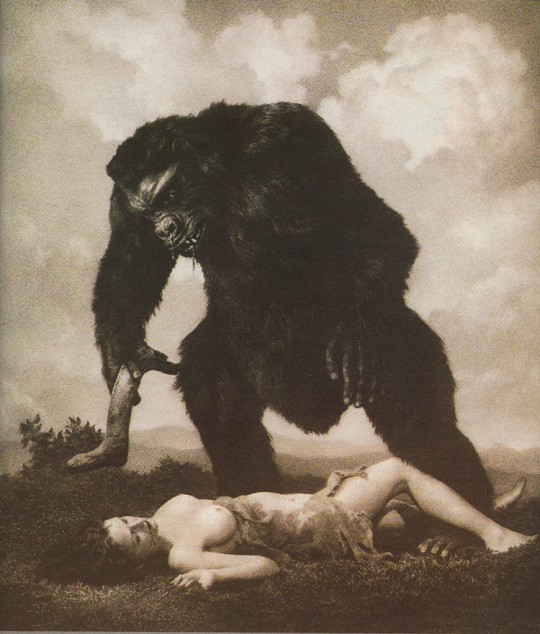
L’Amour (1935). Photograph: William Mortense
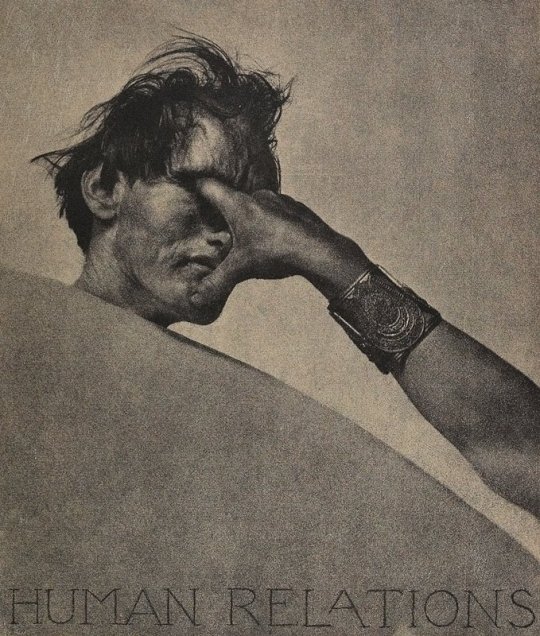
Human Relations 1932 William Mortensen
Debate between Pictorialism and Purism
The fight between purism and pictorialism is all about who is right in the content they produce. It all brings back the question of what is art and what is photography. Does anyone has the right to say a photographic content is wrong just because it does lot follow a certain procedure?
For me this was what was going on with Ansel Adams and William Mortensen. the Pictorialist believed that people believed more about the way purist went about their work because they where often recognized publicly. Then it was difficult to get people to be on the same boat as you with something that is new to them and also in terms of ideas and what one belived and so they was a long drag about photographers making fun of each other in reference to what they chose to photograph and how they chose to carry out a project. I do not think any of them were doing something wrong rather the purisit and and Pictorialist introduced possible different ways on can chose to experess themselves of show people what Is actually around them. Photography to me has always been a way to show people things that influnce me and a journey that takes time to unfold itself.
1 note
·
View note
Text
The Work of Art in the Age of Mechanical Reproduction”Walter Benjamin”
Walter benjamin argues that in the age of mechanical reproduction, art becomes reproducible and thereby gradually loses its traditional and ritualistic value, causing it to lose “aura” and “authenticity.” Benjamin also argues that the technology in his time that allowed for reproduction of works of art degrades aura and authenticity. In this sense, photography, which became accessible in the late 1800's, isn't a work of art portrayed by emanation in that a machine is embedded between the craftsman and his subject.

When reading about Benjamins’s theory of reproduction of art and how technology has taken away the meaning of art due to use of technology to manipulate art. I immediately think of pop art and surrealism. They rae both art movemnet that has been dependant on technology and has been used for years to explore and create.
When i think of an artist who uses technology to his advantage, i think of andy Warhol. He is a master at using technology to reproduce. With the amount of access to technology and the freedom we have to experss ourselves, warhol takes advantage of that freedom by refelecting that in his craft. He uses famous images in addition to his and also works with his images in many different ways such as colors, shadows, shapes, lights etc. These things and also with the help of technology helps warhol to accomplish what he wants.
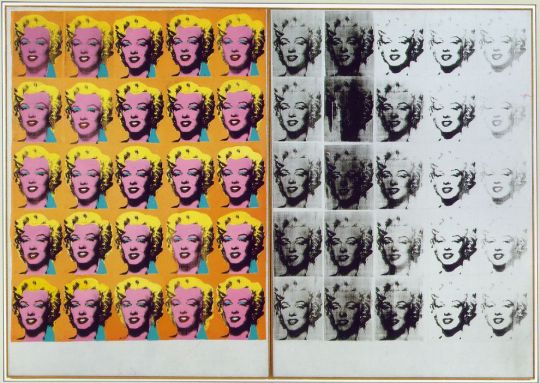
Marilyn Diptych 1962, Here warhol has used color to reproduce the same image over and over again. also Having the image in black and white.

Strenger Friend, 2018
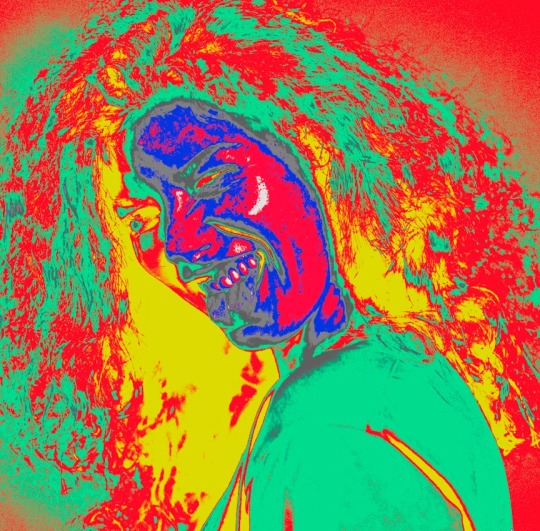
Clea, 2018
Alison Scarpulla experiments with several photographic effects and photo manipulations. She understands the strange power and intriguing beauty of decay. She transforms her already beautiful photographs into even more striking images not by Photoshop, but by her own unorthodox sorcery. In order to achieve a desired effect, Scarpulla sometimes uses expired film, while at other times she smears her lens with dirt. Additionally, she has been known to blow smoke on or drip everything from water to acid on negatives. Her unusual experiments make for excitingly unique and especially beautiful images of all things odd and occult.

Photo Art by Alison Scarpulla
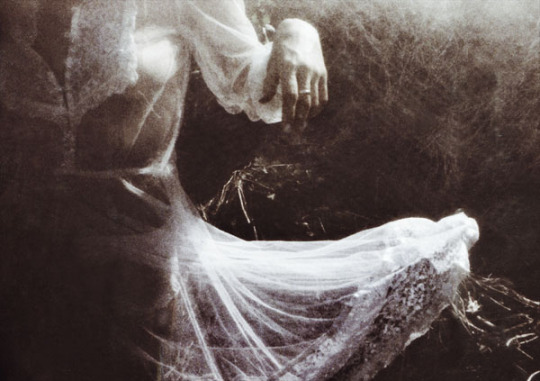
Photographic Artwork by Alison Scarpulla

Dreamlike Photographic Artwork by Alison Scarpulla
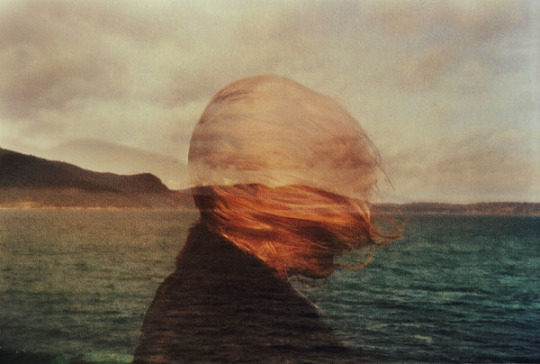
photographic Art by Alison Scarpulla
Antother aritist who’s work i took interest in is Uelsmann. He is a masterful printer, producing composite photographs with multiple negatives and extensive darkroom work. He uses up to a dozen enlargers at a time to produce his final images and has a large archive of negatives that he has shot over the years. Uelsmann does not carry multiple attachments, but only one camera, "Most photographers carry many cameras with multiple attachments. Most photographers have one enlarger. I have half a dozen." When beginning to create one of his photomontages, he has a strong intuitive sense of what he's looking for, some strategy for how to find it, and an understanding that mistakes are inevitable and are part of the creative process.


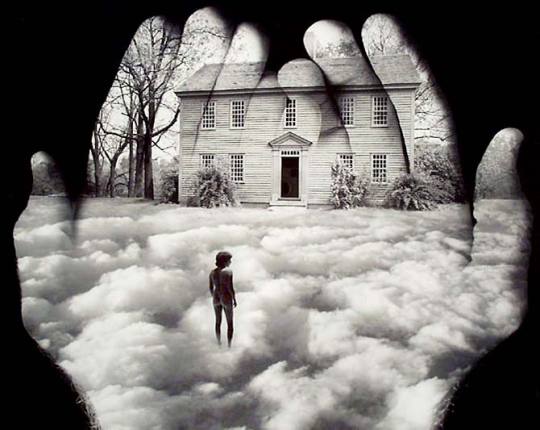

0 notes
Text
STREET PHOTOGRAHY
Before knowing anything about photography, I have always loved going out and exploring through photography. “street photography” was what got me into other parts of photography and with time I am learning these other various parts of the art. There are different things to street photography when you are out exploring. The people, food, building, the street itself etc. Depending on what I am going for, I try to photograph everything and anything without restricting myself.
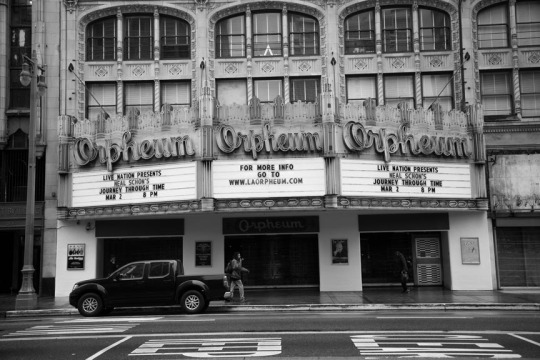
Talking about restrictions, The fun part of street photography to me is that there are no rules involved. The amount of freedom you have to do whatever you feel is right Is one of the most fun parts. One can easily get away with anything when it comes to street photography and that is what I enjoy most. And also, having the freedom to take pictures of anything without having someone tell you it is wrong or right. With street photography, the photographer tries their best to show their audience what they see or how they would want people to see things from different perspectives. Personally I enjoy shooting places and people because we sometimes forget and take things around us for granted maybe because we feel that it/they will be there waiting for us. So just shooting things as they are reminds me of things around me that I neglect. So i keep images that remind me of those things and their growth.

From a very young age I have been alone by myself and I have grown to love being alone. Discovering street photography was a way of interacting with people and keeping myself going with life. It felt like making friends for just a little time. I enjoy how my camera interacts with different people and places I go to. I really welcome any type of reactions. I feel very scared of going to a new place and being a stalker that puts a camera in peoples faces.

It’s not something most people welcome especially not when their day is not going as planned. But being able to see different people on the street with their minds flooded with emotions and their life, I can't help but get drawn. Also, old buildings changing to modern architecture and basically seeing your childhood disappear was very scary to me and I wanted to take as many pictures I could to at least have something to remind me myself of what it felt being in that space at that moment.

People get my attention a lot when it comes to street photography. I am just drawn to people on the street from taking pictures of their reflections or them in their own world very much absent-minded of their environment. Some are very aware and becomes very conscious of the Camry some cared less. Being an introvert the only way I could think to make up for my lack of social skills is by interacting with people through photography.
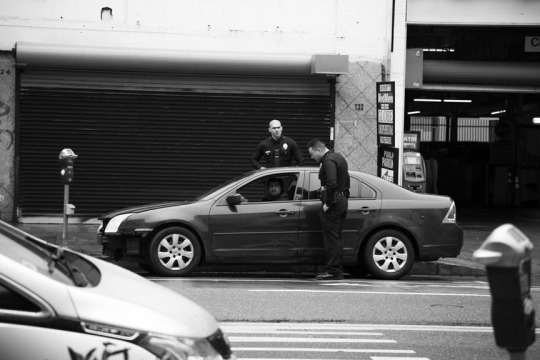


When I am out shooting I can be confident sometimes shooting people without being worried about getting noticed. However, people get really defensive and objective to their pictures taken so it actually depends on how confident I am and also the type of camera I am using. One thing I have noticed is that people get intimidated when they see a long lens and an actual professional camera. But very relaxed when you use your phone camera or a more touristy camera.
One of the best thing to do while taking street photography is being able to blend in. It might from the outfit you wear or your hair and also your camera. The goal is to blend into the public that can even notice your presence. This is the one skill I wish I had to be quick and able to be unnoticed in public while taking pictures.
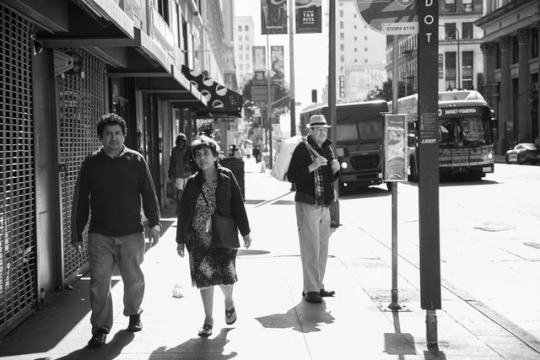
1 note
·
View note
Text
LET US NOW PRAISE FAMOUS MEN
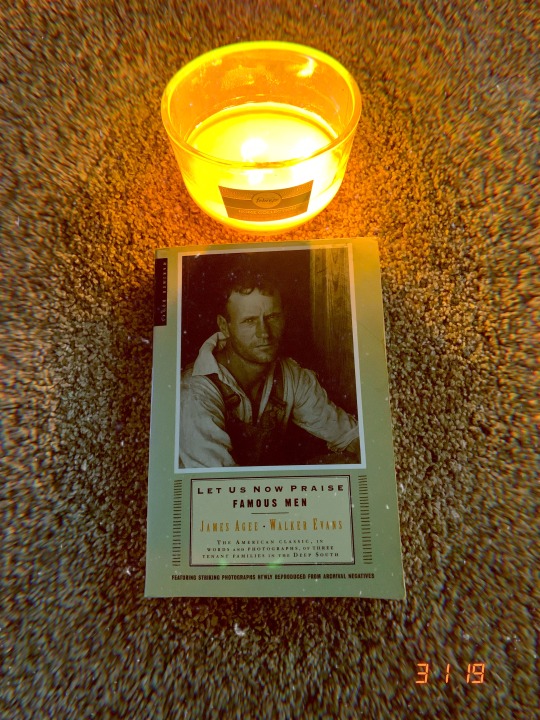
The narrative of how the book came about is as unexpected as the book's title. In the late spring of 1936, as a major aspect of Fortune magazine's "Life and Circumstances" arrangement, Agee and picture taker Walker Evans were given a month-long task to archive the pitiable existences of white tenant farmers in the profound South amid the most exceedingly awful of the Great Depression. They headed to provincial Alabama, as far off socially as one could get from the magazine's central station in the then-new Chrysler Building. They investigated the lives of two sharecroppers and a tenant farmer, whom Agee called the Rickettses, the Woods, and the Gudgers. Agee remained with one of the families, while Evans favored an inn in an adjacent town.
Fortune never distributed the article, yet the work was distributed as a book in 1941, the last year of the New Deal. Around 600 duplicates of the book were sold before it vanished from racks. This book by and by broke journalistic and scholarly traditions was reissued during the 1960s, where it found a group of people. In his audit, Lionel Trilling composed that the book is "the most reasonable and the most essential good exertion of our American age.
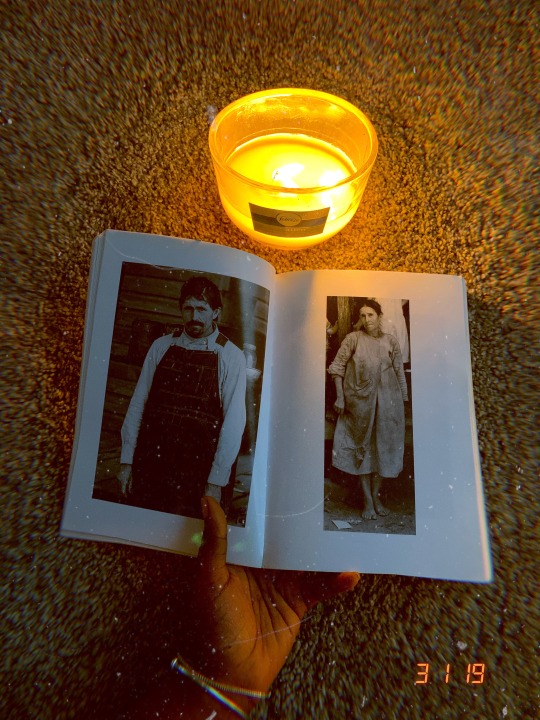
Evans and Agee were an impeccably coordinated pair of alternate extremes. Evans was a serious classicist. His arrangements appear to be extra, with nary a touch of room unused or frilled up. Conversely, the decidedly Byzantine turns of Agee's writing could be depicted as elaborate when precise and strangely extravagant while bumbling off into confusion. However, saw all the more intently, Evans' photographs are thickly finished, belying the appearing lucidity of their surface. Similarly, Agee's despise for the bogus cognizance of account structure, his extreme aversion of the simple verbal catch of the genuine, all things considered and unavoidably now and again surrenders to the requesting components inalienable in even the most peculiar of representations, the most unforeseen of metonymic juxtapositions. For anybody at first supporting the indexical connection to the genuine that the photographic medium proffers, Agee's verbal indulgence demonstrates the ideal contradiction. Any simple allotment Evans' photos is altogether cross examined by Agee's composition, which sends us back to look and look once more.
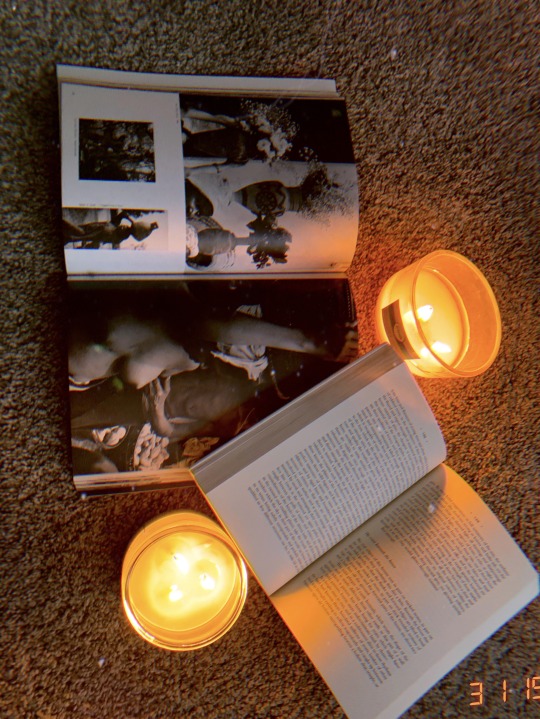
the book is broken down into different parts with each having detialed informations. In the first few pages are few images captured by Walker Evans and Agee. While the other parts of the book is filed with writings.
THE FAMLIY OF MAN

This book is filled with images, location and somtimes the photographer who captured the shots. You basiclly make up your story as you flep through. However, it also draws our attention as to how lifes are the same all around the world. The Family of man has images from different parts of the world doing the same thing or going through similar things. it shows us how indifferent we are although we may look different, speak diiferent and dress different. It teaches us that us that child labour is not different, grief, pain and joy are no different depending on which part of the world you are. The images are well shot, all in black and white removing any distractions and drawing foucs to what is the image.
The book highlights 503 pictures by 273 photographs from the renowned to the unknown which were all utilized by Edward Steichen to coordinate an excellent vision of mankind, showing people around the world working, playing, battling and adoring. They were set cautiously in the design, making a visual and passionate musicality. That would be seen and through which a connection can be made. I believe that the book and collections of the images are meant to be seen together, it has a stronger message when viewed as a collection of series.

The two books I believe has a different message that they want the audience to connect to. let us now praise famous man is practically documenting the lives of the lower class during the great depression in the late 30′s. And the images are meant to draw the attention of the people by feeling sorry for these family and almost putting themselves in their shoes. And also getting people to make contributions to help make their lives better. In the series of pictures in the two books, the images are all on black and white. It was nice because there were consistency and nothing really to distract one from the actual image.
0 notes
Text
MARK SELIGER
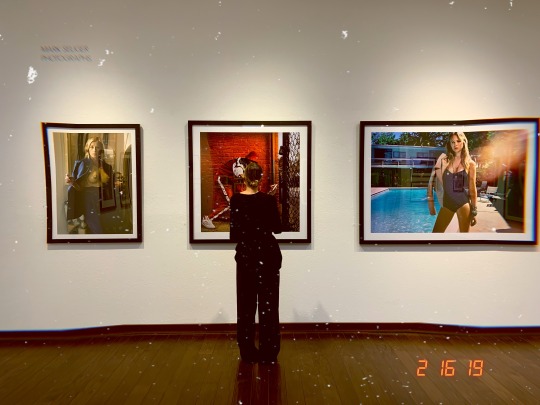
On February 16th, at the Fahey-Klein gallery, we had the pleasure of seeing some of the works of Mark Seliger.
Mark Seliger is an American known celebrity photographer, who has done remarkably well.
Seliger now shoots frequently for Vanity Fair, Italian Vogue, Harper’s Bazaar, Elle and many other magazines. In addition, he shoots advertising work for Adidas, Anheuser-Busch, Levi’s, McDonald’s, Netflix, Ralph Lauren, Ray-Ban.
For more about Mark Seliger.
Mark Seliger’s work does not have any historical or political meaning behind them. He is a photographer exploring the art of photography and has been doing just that in his own artistic way. He is very famous for photographing famous people such as musicians, politicians actors and models but also he is famous for producing loads of unique fine artworks and also he works with a lot of top fashion magazines.
Fahey-Klein gallery showcased a good amount of Seliger works but I was particularly interested and somewhat pique by Pilobolus. For starters, Among all his work this picture has gathered an enormous media coverage as it was.
In the Fahey-Klein gallery, there were loads of amazing works of Mark Seliger but the ones that grabbed my attention was the black and white photographs. They were very interesting to look at and also very captivating. Not knowing anything about him or his work before this trip, I did not know what to expect but from his images displayed one can tell He challenges himself to try different things with photography.
Mark Seliger Nude, New York, April 18, 2002 Platinum palladium, printed 2010, edition of 9
Pilobolus, New York, NY,, 2002
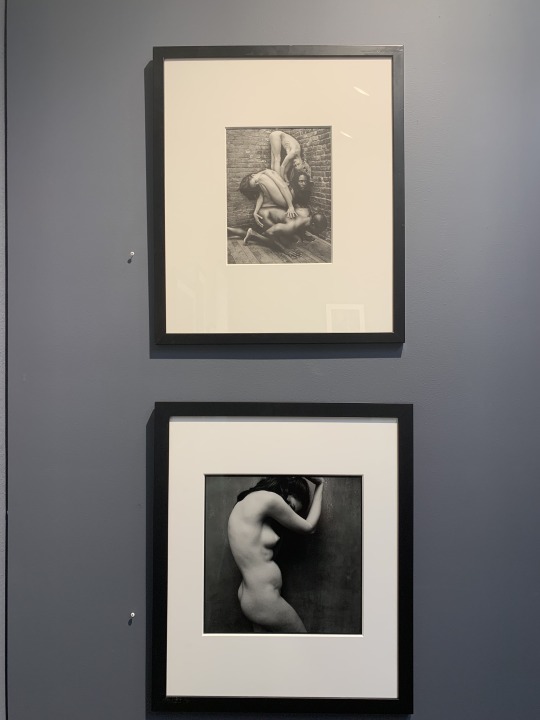
However, “Mark Seliger’s elegiac nude study is a meditation through slow looking that speaks metaphorically of the eternal themes of love and death.”
With the first image, I am almost forced to see differently. It is no longer about the individuals alone but about them all as one body. It is also very interesting that if one looks closely, there are two black men and two white women there might be a hidden meaning behind this but I am not sure, however, the contrast of colours works perfectly with an evenly black and an evenly white, the colours does not overpower each other rather they blend into each other perfectly. This also might be about gender equality or equality with race, seeing that race is a big long lasting issue.
There is also no privacy in this image, with the models very close and attached to each other. This level of intimacy is needed because they need each other as a support system to make the image work.
These 2 images were kind of the most difficult for me to give a back story to or figure out. The bottom one when I first saw it reminded me of classical Greek art. From the way, she is posed and the shapes her body makes was almost like his idea was inspired by an ancient Greek. And I am also reminded of the female fertility. I do not truly understand Seliger meaning behind these above photographs but from my own understanding, Nude is beyond a naked image of a woman rather it is a symbol of women.
Her pose to be seen as synonymous with that of ancient Greek statue. Her edges are well defined and shape yet they give a subtle and sublime feeling to the viewer.
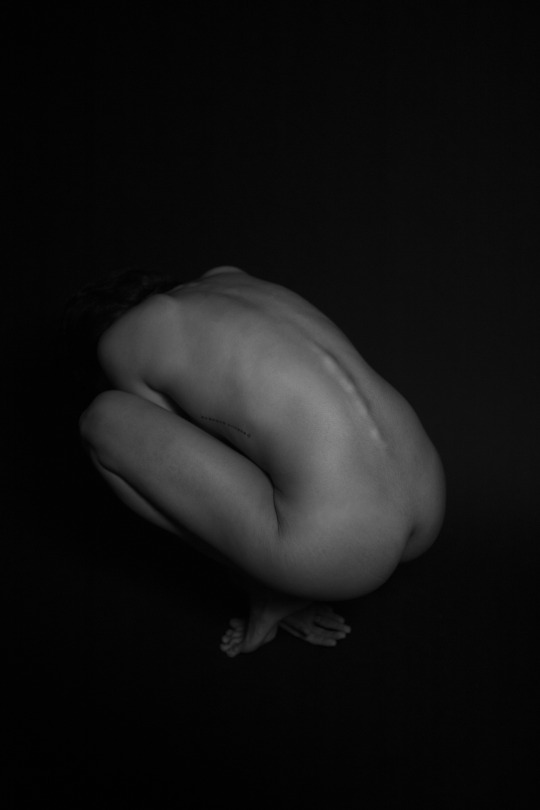
Some similarities between Mark Seliger’s images and mine is that they are both black and white, the images are similar in terms of poses and shapes that the model is creating. I decided to make my images black and white because I did not the viewers to be distracted with colours rather justing having them see things in black white like you rather like something or you don’t.
My thought when I was creating these bodies of work was to get viewers to make up their story from what they see and feel. the more I look the more I figure what my story for these work means to me, almost trying to show the hidden, be it beautiful or ugly.
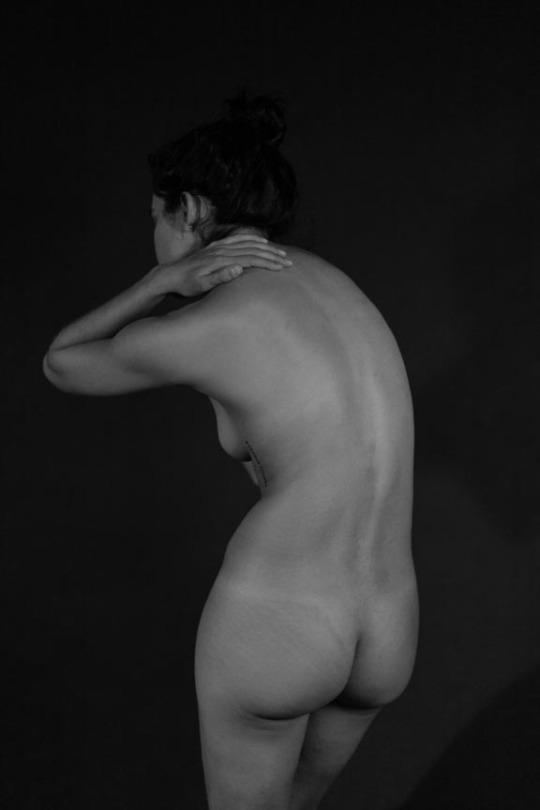
https://www.scoop.it/topic/master-photographers
https://potd.pdnonline.com/2011/03/8655/
https://www.artsy.net/article/artsy-editorial-anne-brigman-pioneering-photographer-nude-self-portraits
http://www.artnet.com/artists/mark-seliger/pilobolus-new-york-ny-a-rEgdTF9ftdMJC7BF-nOBnQ2
http://www.la-photographie-galerie.com/artists/photos-46/seliger.html
https://www.gdcinteriors.com/body-in-greek-art/
0 notes
Text
HISTORY OF PHOTOGRAPHY
With time photography has become alot of different things, Technology has definitely plays its role in photography with the envolving of degital cameras and phones. Photography has come a long way, from the thought of being able to make an image stick on a surafce for long, to being able to replicate. Photographers find ways develope things that has never been done before. However overtime photography has become a repeation of what has already been done. But we still try to develop somthing with a twist of making it ours.

Nicéphore Niépce and Daguerre Are some of the important names one hears if talking about the history of photography. They played important roles in starting things that all photographers use. Growing up I had no idea who these important people in photography were, in fact, I did not know about them until i learnt about them recently at school. Having so much access to the internet and with the use of social media, I saw loads of pictures that I liked without knowing who the photographer was.
I was influenced by loads of street/documentary photographs I saw online.
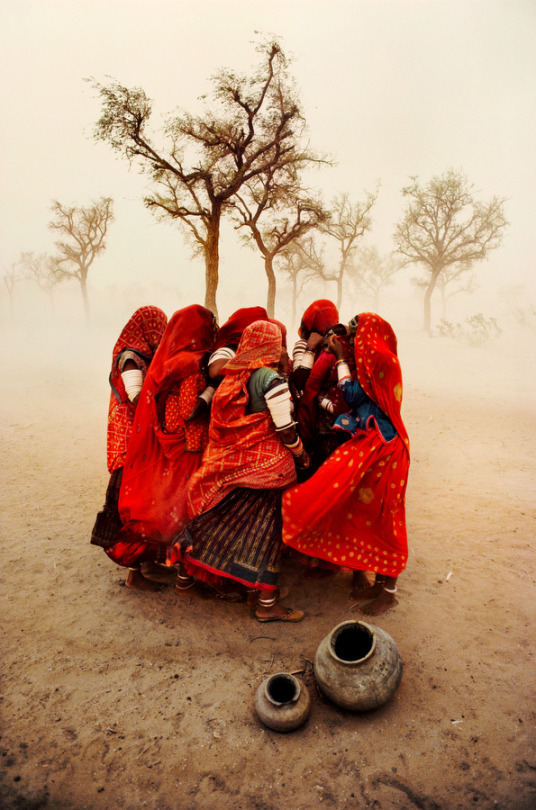
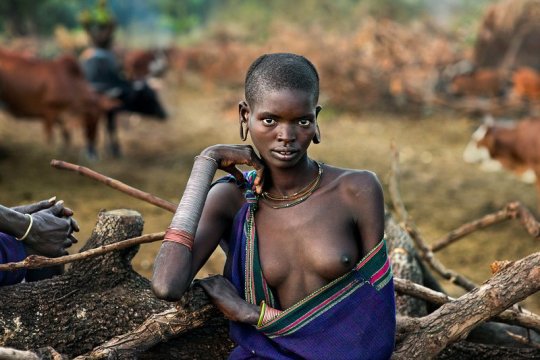
Steve McCurry was one of the photographers that influenced me about to start exploring with photography. For me, his works are rich, daring and filled with so much colour and cultures.
Steve Mccurry is one of my best photographers because Steve travels around the world and captures images from all kinds of places from Pakistan to Afghanistan to the Philippines, India and Ethiopia. Covering grounds from war-zones to people's hometowns and lifestyles And as such inspires me. At that time I wanted to do exactly what he did.
Coming from a country that has so much creativity and culture I was inspired to go out and take pictures of people around me. From family to friends and people I knew nothing about. By doing this I was I learnt things about photography and also things about my culture I would never have learnt.






Moving to the states for my education I was excited but after a while, all my excitement died. I felt like I was forced into doing things I did not want to and have been restricted with so many rules. From photography being freedom to not so much anymore. There were things I was unaware of, things photographers are allowed to do and don’t.
In the mindset of gaining new knowledge about photography and my environment, I had to go back to what inspired me and what I enjoyed doing. which is going out to explore.
It has not been easy but I have had good times with the few times I go out to explore. Hollywood is an interesting place, very different to what I am used to seeing but when you are patient enough you might just be lucky to get a surprise.




https://stevemccurry.com
https://petapixel.com/2015/05/23/20-first-photos-from-the-history-of-photography/
http://www.photo-museum.org/photography-history/
1 note
·
View note